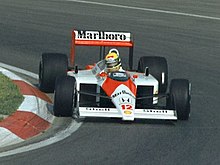Constructors
Since 1981, Formula One teams have been required to build the chassis in which they compete, and consequently the terms "team" and "constructor" became more or less interchangeable. This requirement distinguishes the sport from series such as the IndyCar Series which allows teams to purchase chassis, and "spec series" such as GP2, which require all cars be kept to an identical specification. It also effectively prohibits privateers, which were common even in Formula One well into the 1970s.Early manufacturer involvement came in the form of a "factory team" or "works team" (that is, one owned and staffed by a major car company), such as those of Alfa Romeo, Ferrari, or Renault. After having virtually disappeared by the early 1980s, factory teams made a comeback in the 1990s and 2000s and formed up to half the grid with Ferrari, Jaguar BMW, Renault, Toyota, and Honda either setting up their own teams or buying out existing ones. Mercedes-Benz owned 40% of the McLaren team and manufactures the team's engines. Factory teams make up the top competitive teams; in 2008 wholly owned factory teams took four of the top five positions in the Constructors' Championship, and McLaren the other. Ferrari holds the record for having won the most Constructors' Championships (fifteen). However by the end of the 2000s factory teams were once again on the decline with only Ferrari, Mercedes-Benz and Renault lodging entries to the 2010 championship
.
Companies such as Climax, Repco, Cosworth, Hart, Judd and Supertec, which had no direct team affiliation, often sold engines to teams that could not afford to manufacture them. In the early years, independently owned Formula One teams sometimes also built their engines, though this became less common with the increased involvement of major car manufacturers such as BMW, Ferrari, Honda, Mercedes-Benz, Renault, and Toyota, whose large budgets rendered privately built engines less competitive. Cosworth was the last independent engine supplier, but lost its last customers after the 2006 season. Beginning in 2007, the manufacturers' deep pockets and engineering ability took over, eliminating the last of the independent engine manufacturers. It is estimated the major teams spend between €100 and €200 million ($125–$225 million) per year per manufacturer on engines alone.
In the 2007 season, for the first time since the 1984 rule, two teams used chassis built by other teams. Super Aguri started the season using a modified Honda Racing RA106 chassis (used by Honda in the 2006 season), while Scuderia Toro Rosso used a modified Red Bull Racing RB3 chassis (same as the one used by Red Bull in the 2007 season). This decision did not come as a surprise as costs are increasing, Super Aguri is partially owned by Honda, and Toro Rosso half-owned by Red Bull. Formula One team Spyker raised a complaint against this decision, and other teams such as McLaren and Ferrari have officially confirmed they support the campaign. Because of this use of other teams' chassis, the 2006 season could have been the last one in which the terms "team" and "constructor" were truly interchangeable. This attracted the Prodrive team to F1 to the 2008 season, where it intended to run a customer car. After not being able to secure a package from McLaren, Prodrive's intention to enter the 2008 season was dropped after Williams threatened legal action against them. Now, it seems customer cars will be formally banned in 2010.
Although teams rarely disclose information about their budgets, it is estimated they range from US$66 million to US$400 million each.
Entering a new team in the Formula One World Championship requires a £25 million (about US$47 million) up-front payment to the FIA, which is then repaid to the team over the course of the season. As a consequence, constructors desiring to enter Formula One often prefer to buy an existing team: B.A.R.'s purchase of Tyrrell and Midland's purchase of Jordan allowed both of these teams to sidestep the large deposit and secure the benefits the team already had, such as TV revenue.
 1:33 AM
1:33 AM
 MUHAMMAD USMAN AWAN
MUHAMMAD USMAN AWAN




 Posted in:
Posted in: 






0 comments:
Post a Comment